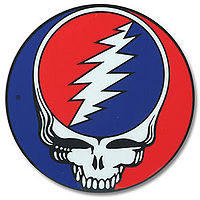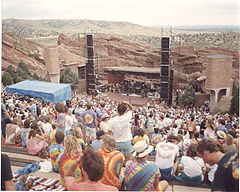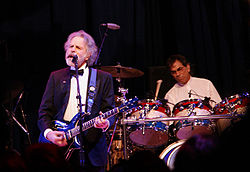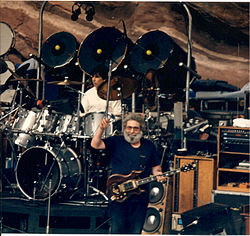- Deadhead
-
For other uses, see Deadhead (disambiguation).
 Designed by Bob Thomas and Owsley Stanley, this symbol, which became known as a "steal your face", was featured inside the album jacket of the self-titled Grateful Dead album along with the address to their fan club.
Designed by Bob Thomas and Owsley Stanley, this symbol, which became known as a "steal your face", was featured inside the album jacket of the self-titled Grateful Dead album along with the address to their fan club.
Deadhead or Dead Head is a name given to fans of the American jam band, the Grateful Dead.[1][2][3][4][5] In the 1970s, a number of fans began travelling to see the band in as many shows or festival venues as they could. With large numbers of people thus attending strings of shows, a community developed. Deadheads developed their own idioms and slang.
Contents
Overview
By the late 1970s, some Deadheads began to sell tie-dye t-shirts, veggie burritos, or other items at Grateful Dead concerts. This allowed many Deadheads a way to follow the band on its tours. During the early 1980s, the number of Deadheads taping shows increased, and the band created a special section for fans who wished to record the show. These tapes are still shared and circulated today, and never sold.[citation needed] In the earlier days of the Grateful Dead, there was question as to whether or not allowing concert-taping was in the best interest of the band, to which Garcia replied something similar to, "When we are done with it [the concerts] -- they can have it." The practice of taping has continued into the digital age; and the rise of the Internet has made it extremely easy to share new shows as well as older.
Origins
The term first appeared in print at the suggestion of "Hank Harrison": author of The Dead Trilogy on the sleeve of Grateful Dead (also known as Skull & Roses), the band's second live album, released in 1971.[6] It read:
“ DEAD FREAKS UNITE: Who are you? Where are you? How are you?
Send us your name and address and we'll keep you informed.
Dead Heads, P.O. Box 1065, San Rafael, California 94901.” This phenomenon was first touched on in print by Village Voice music critic Robert Christgau at a Felt Forum show in 1971, noting "how many 'regulars' seemed to be in attendance, and how, from the way they compared notes, they'd obviously made a determined effort to see as many shows as possible."[6]
Eileen Law, a long time friend of the band, was put in charge of the mailing list and maintained the Dead Heads newsletter. It is estimated that by the end of 1971, the band had received about 350 letters, but this number swelled greatly over the next few years to as many as 40,000.[6] In total, 25 mailings/newsletters reached Dead Heads between October 1971 and February 1980. After this time, the Grateful Dead Almanac would succeed it, with this eventually being abandoned for Dead.net.[6] Those who did receive the newsletter in the 1970s often found pleasant surprises sent along. One example is from May 1974 when Heads received a sample EP of Robert Hunter's upcoming album Tales of the Great Rum Runners as well as selections from Jerry Garcia's second album, Compliments of Garcia. This sample was titled Anton Round, which was an alias used by Ron Rakow.[6]
Impact on shows
 Fans attending a Grateful Dead concert at Red Rocks, Colorado, 1987.
Fans attending a Grateful Dead concert at Red Rocks, Colorado, 1987.
The Grateful Dead's appeal to fans was supported by the way the band structured their concerts:
- From the early 1970s on, night to night song selection changed over subsequent shows.
- Also from the early 1970s on, it could be expected that the band would play two sets in a show.
- From the 1980s on, the second set usually contained a prolonged drum solo, called "Drumz", by Mickey Hart and Bill Kreutzmann (also known as the "Rhythm Devils") followed by an extended improvisational "space" jam played by the rest of the band (See the album "Infrared Roses").
The varied song selection allowed the band to create a "rotation" of songs that was roughly repeated every 3 to 4 performances ("shows"). The rotation created two phenomena. The first was the desire of deadheads to hear their song or hit a good show, which meant that deadheads began traveling between various cities on tour to see the band. The second phenomenon was that the large number of traveling fans also permitted the band to perform multiple shows in a single venue and be assured that the performances would be mostly sold out, as almost all were from the mid 1980s on.[citation needed] With large numbers of people thus attending strings of shows, a community developed out of the familiarity. As generations turned from the acid tests to the 1970s (and onward), tours became a time to revel with friends at concerts, old and new, who never knew the psychedelic age that spawned the band they loved.[7] As with any large community, Deadheads developed their own idioms and slang which is amply illustrated in books about the Grateful Dead such as the Skeleton Key.
Some Deadheads use the term "X Factor" to describe the intangible element that elevates mere performance into something higher.[8] Publicist and Jerry Garcia biographer Blair Jackson stated that "shows were the sacrament ... rich and full of blissful, transcendent musical moments that moved the body and enriched the soul."[9] Phil Lesh himself comments on this phenomenon in his autobiography by saying "The unique organicity of our music reflects the fact that each of us consciously personalized his playing: to fit with what others were playing and to fit with who each man was as an individual, allowing us to meld our consciousnesses together in the unity of a group mind.".[10]
Jackson takes this further, citing drummer Mickey Hart as saying "The Grateful Dead weren't in the music business, they were in the transportation business." Jackson relates this to the Deadhead phenomenon directly by saying "for many Deadheads, the band was a medium that facilitated experiencing other planes of consciousness and tapping into deep, spiritual wells that were usually the province of organized religion ... [they] got people high whether those people were on drugs or not." (For more on the spiritual aspect, see Spinners in the section below). It was times like these that the band and the audience would become one; The Grateful Dead and the Deadheads were all in the same state of mind.[11]
Rock producer Bill Graham summarized much of the band's effect when he created a sign for the Grateful Dead when the group played the closing of the Winterland Ballroom on December 31, 1978 that read:[12]
“ They're not the best at what they do,
They're the only ones that do what they do.
Cheers!
Bill & the Winterland Gang” Deadheads through the years
- 1960s - Before the term was invented, The Grateful Dead became one of the first cult acts in music. Although not as mainstream as other psychedelic bands, they were the leaders of the Haight-Ashbury music scene and had an intense following that started in San Francisco and eventually spread. Fans gathered at their jam concerts throughout the sixties.
- 1970s - essentially known as the "second generation of Deadheads," the new Deadheads of this time can either be traced to "an older sibling who had turned them on by spinning Workingman's Dead or Europe '72" or through college and university dorm rooms.[7]
- 1980s - The early 1980s brought about what would later become known as "Shakedown Street" (in reference to the Grateful Dead album of the same name). Started during the New Year's Eve shows at the Oakland Auditorium in California from 1979–1982, Deadheads began to realize they could sell their wares (anything from tie-dye t-shirts to veggie burritos) in order to follow around the band more. Also during the early '80s, Deadhead tapers grew exponentially, resulting in the band designating a taping section in October 1984.[13] With the success of their album In the Dark (and the single "Touch of Grey"), 1988 started the "Mega-Dead" period.[14]
-
- In the Darkers - also known as "Touchheads" (a reference of the album for the former and the single for the latter), these fans "dissed the fragile ecosystem" of a Grateful Dead show, in the words of Jackson. This led to "wiser" Deadheads, with the backing of the band, to mail SOS's and hand out show flyers telling people to "cool out."[14]
-
- Minglewood Town Council - this group was a direct result of the Touchheads and were a "tribal council" consisting of Deadheads and the Hog Farmers Calico and Goose. They handed out garbage bags at shows for people to pick up trash afterwards and tried to keep the masses mellow.[14]
- 1990s - The Deadheads of this time "tended to be young, white, male, and from middle-class backgrounds -- in short, they were drawn from much the same demographic base as most rock fans." The band also tended to attract a large percentage of fans from high-income families. The main draw for these Deadheads to travel to shows seemed to be the sense of community and adventure. During the mid-90's there were a series of small "Deadhead Riots" peaking with a large scale riot at the Deer Creek Music Center near Indianapolis in July 1995. The riot was triggered by several gatecrashing incidents and resulted in the fence at the venue being torn down by rioting Deadheads and subsequently the cancellation of the next day's show. The riot received national attention and is immortalized by Keller Williams in his song "Gatecrashers Suck" in which he calls the rioters "cock sucking motherfuckers."[15]
- 21 Century Deadheads - Many dead fans of all ages continue to follow Grateful Dead family musical incarnations such as The Donna Jean Godchaux Band, Jerry Garcia Band, Ratdog, Phil and Friends, 7 Walkers, The Rhythm Devils, The Dead, Furthur, and Dark Star Orchestra.
- The Spinners - also known as "The Family" or Church of Unlimited Devotion. These people "used the band's music in worship services and were a constant presence at shows." They were called "spinners" because of their twirling dance style.[15]
- Wharf Rats - Deadheads who helped each other remain drug and alcohol free while staying in the Dead scene.[16]
- Wookiees aka Wooks - named after the Star Wars character, Chewbacca, these die hard fans are known for their hairy, unkempt appearance, and their dedication to living on the road or off the grid.
Recordings of shows
 Bob Weir and Mickey Hart of the Grateful Dead performing on January 20, 2009 at the Mid-Atlantic Inaugural Ball during President Barack Obama's Inaugural
Bob Weir and Mickey Hart of the Grateful Dead performing on January 20, 2009 at the Mid-Atlantic Inaugural Ball during President Barack Obama's Inaugural
At almost every Grateful Dead show, it was common to see fans openly recording the music for later enjoyment. This can be traced to shows in the late 1960s, with the number of tapers increasing yearly. In 1971, Les Kippel, from Brooklyn, NY, started the First Free Underground Grateful Dead Tape Exchange. This started a new era in recording, collecting, and trading Grateful Dead Tapes. Often referred to as 'the Original Napster", the tape exchange grew into an international movement that continues today. The Tape Exchange grew into 'Dead Relix', a tapers magazine which became RELIX MAGAZINE in 1974 and Relix Records in 1980.
The Grateful Dead Fans (Dead Heads) were one of the main driving forces keeping the band going. The purpose of "The First Free Underground Grateful Dead Tape Exchange" was to preserve the heritage of the Grateful Dead's concert history by exchanging copies of recorded tapes made from the audiences of shows.
The Tape Exhange evolved into Dead Relix Magazine with its first fliers being handed out at concerts in 1973, followed by it first issue in 1974. Dead Relix evolved into Relix Magazine and kept the Grateful Dead in the news while they took a year off in 1975.
There were other magazines that came about in the 1970s, Notably, "Dead in Words", and "In Concert".
In the 1980s, after seeing the continued growth of Dead Relix, other business minded individuals tried to get in on the action and produced a number of Grateful Dead related magazines. "Acid", "Dupree's Diamond News", Terrapin Flyer", and "Golden Road" are examples of those magazines.
None of those publications survived. The longest one, "Golden Road" closed after 10 years.
Toni Brown, who became Owner and Publisher of Relix Magazine in 1980, sold the magazine to Steve Bernstein in 2000. Relix Magazine is the second oldest continuously published rock magazine in the world, after Rolling Stone.
Relix is still the only publication that supports the heritage of the Grateful Dead.
Another group of Dead Heads were the "Wharf Rats". They got their name from the song and were allowed to set up a table at every concert to support Dead Heads who believed in enjoying the Grateful Dead sober or needed support in their efforts to remain straight.
Other Dead Head factions included the "Rainbow Tribe', "Gay Dead Heads" and 'Jews for Jerry".
The 'Vibe' of the Grateful Dead is kept alive today by many festivals that celebrate their traditions.
Fans were also known to record the many FM radio broadcasted shows. Garcia looked kindly on tapers (he himself had been on several cross-country treks to record bluegrass music prior to the Grateful Dead), stating "There's something to be said for being able to record an experience you've liked, or being to obtain a recording of it ... my responsibility to the notes is over after I've played them." In this respect, the Dead are considered by many to be the first "taper-friendly" band.[17]
It is a matter of strict custom among Deadheads that these recordings are freely shared and circulated with no money ever changing hands. Some bootleg recordings from unscrupulous bootleggers have turned up on the black market, but a general "code of honor specifically prohibited the buying and selling of Dead tapes." These recordings, sometimes called "liberated bootlegs," still are frowned upon by the community and that feeling "has spread into non-Grateful Dead taping circles."[17]
Many deadheads now freely distribute digital recordings of the Grateful Dead's music, and there are several websites which provide and promote legal access of lossless music. The following are some among the most notable:
Celebrity deadheads
 Members of the Grateful Dead performing at Red Rocks Amphitheatre in Colorado on August 11, 1987.
Members of the Grateful Dead performing at Red Rocks Amphitheatre in Colorado on August 11, 1987.
The following celebrities have claimed to be deadheads or have had media reported on them saying they are deadheads:
- Alex Allan - Chairman of the Joint Intelligence Committee and former British High Commissioner to Australia.[18]
- Tony Blair - played in "Mars Hotel"-inspired student band[19]
- Joseph Campbell - proclaimed deadheads as "the world's newest tribe."[19][20]
- Tucker Carlson[21]
- Pete Carroll[22]
- Bill Clinton[19][23]
- Owen Chamberlain - claimed the Rhythm Devils gave him "interesting ideas"[19]
- Ann Coulter, Conservative comentator and author[24]
- Walter Cronkite - Attended two Grateful Dead concerts[25] and was a personal friend of Mickey Hart.[26]
- Lila Downs - Mexican/American singer, who dropped out of university in the late 1980s and lived about two years on the road following Grateful Dead tours.[27]
- Al Franken[28]
- Whoopi Goldberg is a fan of Grateful Dead music and personal friend of Mickey Hart.[29][30]
- Jerry Greenfield[31]
- Keith Haring[19]
- Phil Jackson[19][28]
- Christopher Kimball tv cook, cover band Shady Grove [32]
- Patrick Leahy[19][33]
- Mike Lookinland, Actor - Bobby Brady[34]
- Frank Marino - Canadian rock guitarist has in interviews talked about his interest in classic San Francisco rock [35]
- Mark Noworyta- Former hockey player
- President Barack Obama inspired the Dead's 2009 spring tour and had them play at his inauguration.
- Carl and Larry Page[36]
- Nancy Pelosi, CBS News (2006).[37]
- Henry Rollins and Greg Ginn of Black Flag.
In a BAM review of a Dead show in Irvine, California, on April 13, 1985, the author wrote: "So-called adventuresome people who dig Black Flag probabably wouldn't be caught alive at a Grateful Dead show". Ginn subsequently wrote to BAM to explain that he and other members of Black Flag had attended the concert being reviewed, that he had attended many Dead shows and that the Grateful Dead was his favorite band. (Source: Winter 1986 issue of the Grateful Dead fanzine The Golden Road. Publisher for the fanzine was well-known journalist Blair Jackson.) - Patrick Volkerding[38] - Founder and maintainer of the Slackware Linux distribution.
- Bill Walton[19][28][39] - known as "Grateful Red", frequently included Dead references in interviews
- William Weld - Former Governor of Massachusetts.[40]
References
- ^ New York Times (2006). I Saw a Deadhead Sticker on a Bentley. Retrieved July 1, 2006.
- ^ Globe Newspaper Company (2006). Boston Globe article: Life of the party using the term Deadhead. Retrieved July 1, 2006.
- ^ Missoula Independent (2006). Article from Montana's largest weekly newspaper: Puppet master, Vol. 17 No. 26, using the term Deadhead, Retrieved July 1, 2006.
- ^ Santa Monica Mirror (2005). Article from Santa Monica newspaper: Local Artists Complete SMC’s Art Mentor Program, Vol. 8, Issue 3, using the term Deadhead, Retrieved July 1, 2006.
- ^ AScribe Newswire (2006). Article from non-profit news distribution organization: Central Valley scientist looks at music's ‘heady’ experience, using the term Deadhead, Retrieved July 1, 2006.
- ^ a b c d e Grateful Dead: The Illustrated Trip edited by Jake Woodward, et al. Dorling Kindersley Limited, 2003, pg. 138.
- ^ a b Grateful Dead: The Illustrated Trip edited by Jake Woodward, et al. Dorling Kindersley Limited, 2003, pg. 174.
- ^ Grateful Dead: The Illustrated Trip edited by Jake Woodward, et al. Dorling Kindersley Limited, 2003, pg. 113.
- ^ Garcia: An American Life by Blair Jackson, Penguin Books, 1999, pg. 219.
- ^ Searching for the Sound: My Life with the Grateful Dead by Phil Lesh, Little, Brown, April 2005
- ^ Garcia: An American Life by Blair Jackson, Penguin Books, 1999, pg. 319.
- ^ Grateful Dead: The Illustrated Trip edited by Jake Woodward, et al. Dorling Kindersley Limited, 2003, pg. 227.
- ^ Grateful Dead: The Illustrated Trip edited by Jake Woodward, et al. Dorling Kindersley Limited, 2003, pg. 263.
- ^ a b c Grateful Dead: The Illustrated Trip edited by Jake Woodward, et al. Dorling Kindersley Limited, 2003, pg. 315.
- ^ a b Grateful Dead: The Illustrated Trip edited by Jake Woodward, et al. Dorling Kindersley Limited, 2003, pg. 415.
- ^ "The Wharf Rats". Wharfrat.org. http://www.wharfrat.org/index.html. Retrieved 22 September 2010.
- ^ a b Garcia: An American Life by Blair Jackson, Penguin Books, 1999, pg. 277.
- ^ "Curriculum Vitae of Alex Allan". http://www3.clearlight.com/~acsa/CV2.htm.
- ^ a b c d e f g h Grateful Dead: The Illustrated Trip edited by Jake Woodward, et al. Dorling Kindersley Limited, 2003, pg. 375.
- ^ Grateful Dead: The Illustrated Trip edited by Jake Woodward, et al. Dorling Kindersley Limited, 2003, pg. 330.
- ^ "SUVs, Canadians and the Grateful Dead". http://www.msnbc.msn.com/id/8063563. Retrieved 2007-06-15.
- ^ "Rose Bowl: Carroll the life of Southern Cal's party". MySA.com. December 31, 2006. http://www.mysanantonio.com/sports/stories/MYSA010106.1C.FBCrosebowl.carroll.31f5fea.html.
- ^ Garcia: An American Life by Blair Jackson, Penguin Books, 1999, pg. 456.
- ^ "Meet Ann Coulter--Deadhead". Democraticunderground.com. http://www.democraticunderground.com/discuss/duboard.php?az=view_all&address=132x2730595. Retrieved 22 September 2010.
- ^ Harper's Index, Source: Marlene Adler, spokeswoman for Walter Cronkite (N.Y.C.). Retrieved May 2009.
- ^ Celebrating Cronkite at 90, from CBS News. Retrieved May 2009.
- ^ "Culturbase, Bio". http://www.culturebase.net/artist.php?231#bio.
- ^ a b c Garcia: An American Life by Blair Jackson, Penguin Books, 1999, pg. 415.
- ^ "Rolling with the Dead (article)". Rollingstone.com. http://www.rollingstone.com/rockdaily/index.php/2009/03/31/rolling-with-the-dead-legends-rock-three-back-to-back-shows-in-new-york/. Retrieved August 2009.
- ^ "Dead World Roundup". Grateful Dead Official Website. http://www.dead.net/features/dead-world-roundup/road-again-rockin-faithful-and-good-causes-few-minutes-phil-lesh. Retrieved August 2009.
- ^ "Company News; Ben & Jerry's". The New York Times. July 30, 1987. http://query.nytimes.com/gst/fullpage.html?res=9B0DE6D9173EF933A05754C0A961948260&n=Top%2fReference%2fTimes%20Topics%2fPeople%2fG%2fGarcia%2c%20Jerry. Retrieved 2007-06-16.
- ^ Sagon, Candy (February 18, 2004). "King Of the Kitchen". The Washington Post. http://www.washingtonpost.com/ac2/wp-dyn/A47549-2004Feb17.
- ^ "Patrick Leahy at Vermont Senate.gov". http://leahy.senate.gov/vermont/chats/chat980506.html.
- ^ "A Greg-Shaped Box". Gettingit.com. http://www.gettingit.com/article/35.
- ^ "Kaos2000 Magazine". http://www.kaos2000.net/interviews/frankmarino/.
- ^ Vise, David A.; Malseed, Mark (2006). "When Larry met Sergey". The Google Story (2nd edition ed.). Delacorte Press. pp. 22. ISBN 0-330-44005-5.
- ^ "The Skinny: Follow The Money? Nah". CBS News. January 4, 2007. http://www.cbsnews.com/stories/2007/01/04/the_skinny/main2329383.shtml. Retrieved 2007-01-04.
- ^ "Interview with Patrick Volkerding". Linux Journal. April 1, 1994. http://www.linuxjournal.com/article/2750. Retrieved 2011-07-18.
- ^ "Press Release". http://billwalton.com/dead_press_release.html.[dead link]
- ^ Sadness From the Streets to High Offices John Markoff New York Times | appeared in paper 8-10-95
Hippies History People and groups Ken Kesey and the Merry Pranksters · Diggers · San Francisco Oracle · Haight Ashbury Free Clinics · Haight-Ashbury Switchboard · Yippies · The Brotherhood of Eternal Love · Jesus movement · Rainbow Family · Deadhead · New Age travellers · Radical FaeriesPolitics and ethics Free love · Anti-authoritarianism · Simple living · Environmentalism · Pacifism · Communalism · Counterculture · Bohemianism · Make love, not war · Turn on, tune in, drop out · VegetarianismCulture and fashion Psychedelia · Flower power · Hippie trail · Happening · Peace symbols · Bell-bottoms · Long hair · Tie-dye · Intentional community · Free festival · Music festival · Flower child · List of films related to the hippie subculture · List of books and publications related to the hippie subcultureMusic Folk rock · Psychedelic rock · Folk music · Psychedelic folk · Progressive rock · Jam bands · Psychedelic trance · Psychedelic music · World music · New Age music · Space rockRelated subjects Categories:- Grateful Dead
- Hippie movement
- Musical subcultures
- Counterculture festivals activists
Wikimedia Foundation. 2010.
